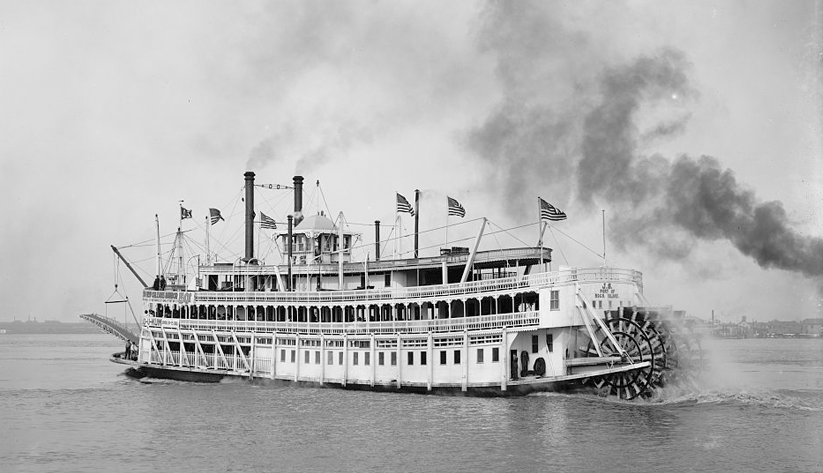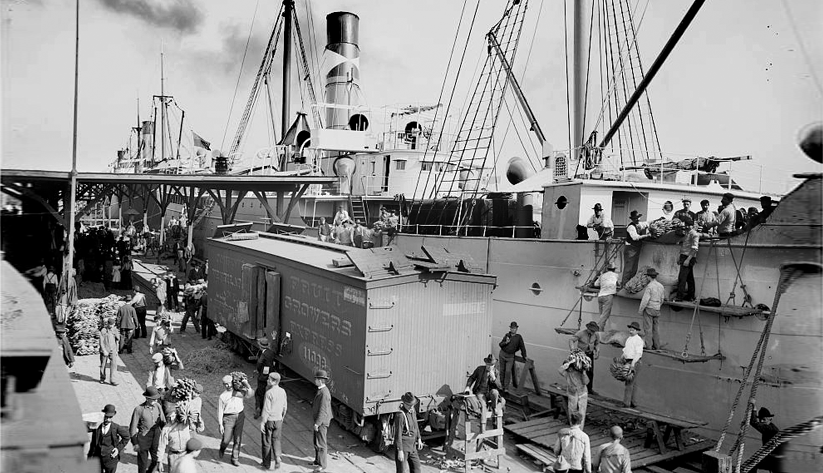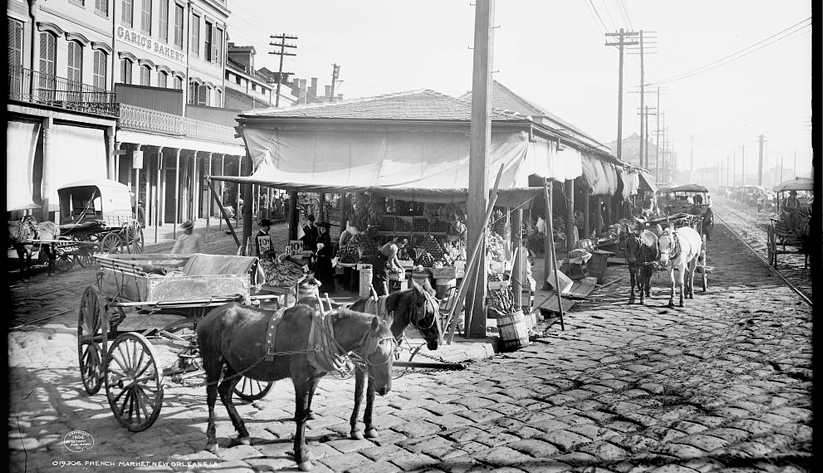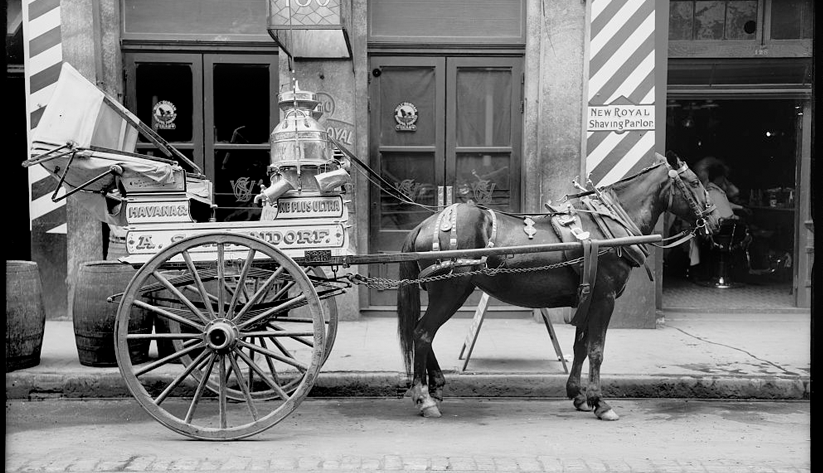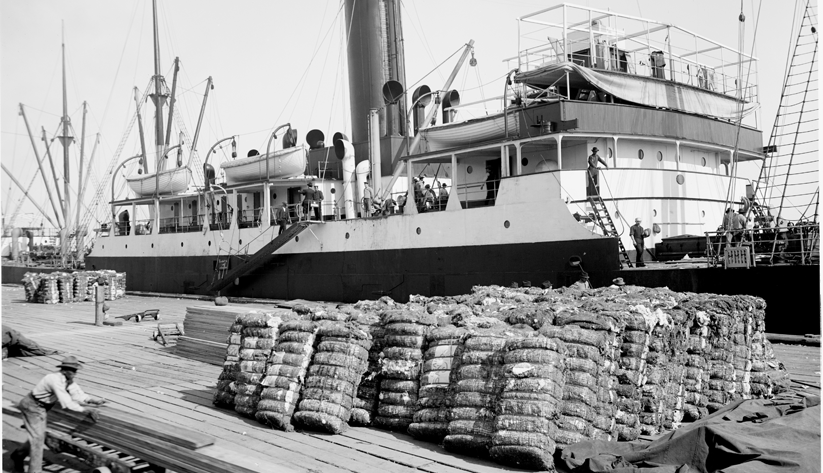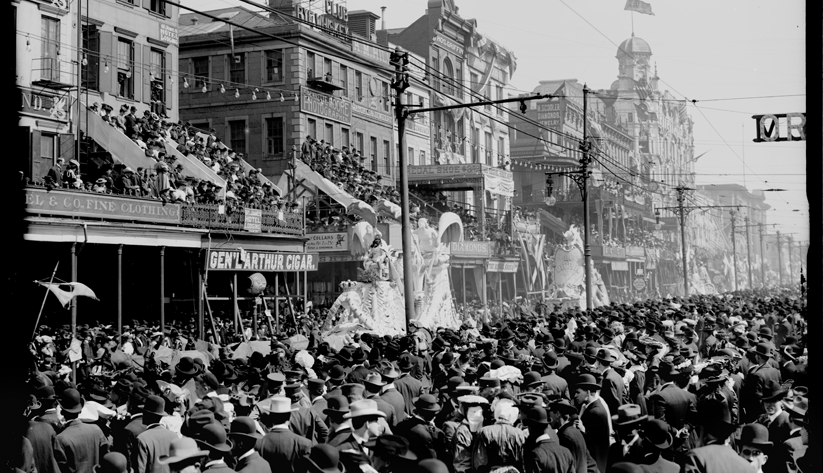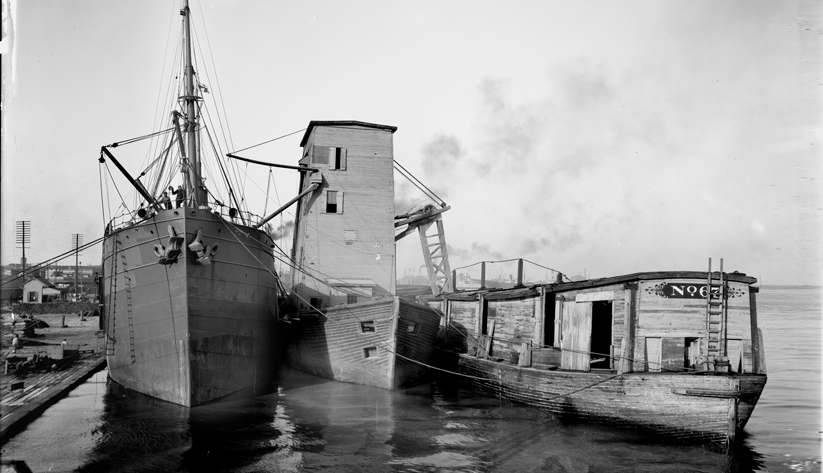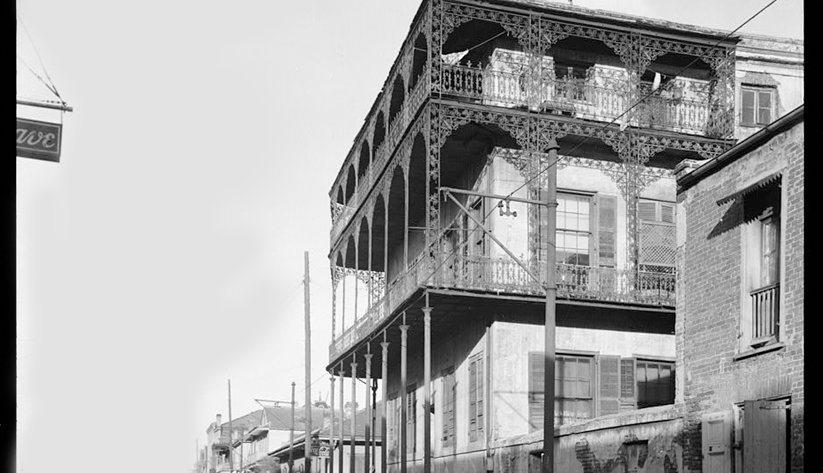Editor's note: This is the third story in a series exploring the economic histories of the largest metropolitan areas in the Southeast.
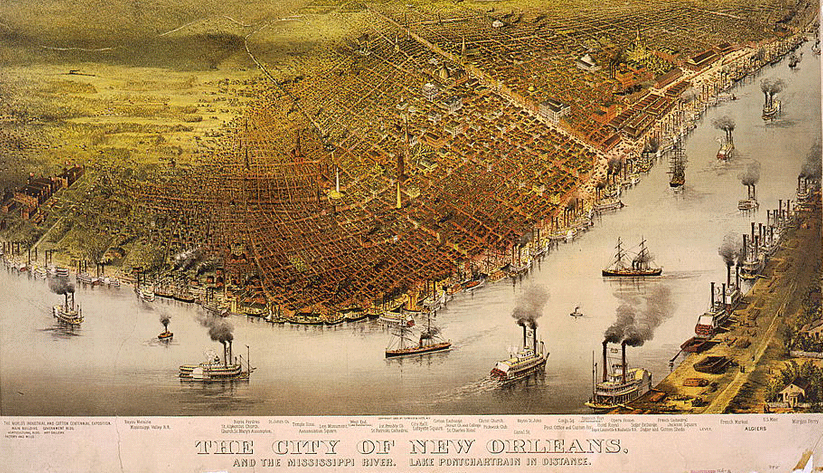
A birds-eye perspective on New Orleans ca. 1885, with the Mississippi River in the foreground. Image courtesy of the Library of Congress photographic archives
American cities don't get much more historic than New Orleans.
Consider that many Sunbelt metropolises had formative growth spurts in the past 35 years. New Orleans had its first big influx of people in the early 1800s. Its population, along with Mississippi River trade, continued to surge through the first half of the 19th century. Nearby sugar and cotton plantations made New Orleans the legal, financial, and commodities-processing capital of the South.
"Throughout the antebellum era, the port ranked second only to New York in traffic, while the city's population doubled roughly every fifteen years," writes Richard Campanella, a Tulane University geographer who has published extensively on the history of New Orleans.
Approaching its tricentennial next year, New Orleans remains largely shaped—physically and economically—by the twin forces of nature and society: the river that led to the city's founding, the oil industry that arose more than 100 years ago, and a distinctive cultural gumbo that has developed over the centuries.
"The river is the reason we're here, and to this very day it's still a mainstay of why we are a critical piece of the nation's economy," said Mark Romig, president and chief executive officer of the New Orleans Tourism Marketing Corporation and a member of the Atlanta Fed's Travel and Tourism Advisory Council.
Straddling the Mississippi for several miles is the Port of New Orleans, which is responsible for 160,000 jobs in Louisiana, according to the facility's data. Largely because of the port, no major metropolitan area in America has a greater concentration of sailors, marine oilers, captains, mates, and ship pilots than New Orleans, according to the U.S. Bureau of Labor Statistics' location quotient, which gauges the density of occupations compared to the national average. New Orleans also ranks behind only Norfolk, Virginia, as a center of ship engineers.
Other massive cargo-handling operations are nearby. Four of the nation's 13 busiest ports ranked by tonnage of material handled lie along the Mississippi between Baton Rouge, about 90 miles upriver from New Orleans, and the Gulf of Mexico.
"The economy very much still operates around the port today," noted Adrienne Slack, vice president and regional executive of the New Orleans Branch of the Atlanta Fed.
Culture flows from the river
The Mississippi has long carried more than cargo. For more than three centuries, it has fed industry and brought people to New Orleans. Petrochemical plants dot the river banks.
In raw numbers, though, New Orleans's biggest single employer is the service sector. Occupations in the leisure and hospitality category account for about 18 percent of the New Orleans metro area's total employment, compared to roughly 10 percent of national employment. The tourism and hospitality industry, said Campanella, "rests squarely on the city's rich history and culture, namely food, music, architecture, and a vast inventory of historical neighborhoods."
The port and river also helped shape a culture intertwined with maritime commerce. In addition to cotton, sugar, and rice, 19th-century New Orleans trade included money and, importantly, information. "The docks were a space of not just trade, but the movement of ideas," according to Justin Wolfe, a Tulane historian.
In fact, the port is where news of the Haitian Revolution reached New Orleans, according to Wolfe. That successful slave revolt, spanning 1791–1804, led to an influx of some 9,000 people into South Louisiana in the early 1800s. The arrival of people from Haiti and elsewhere in Latin America and Europe—immigration fueled largely by trade—helped form the distinctive culture New Orleans boasts to this day.
Energy, Optimism, and Challenges
Today's New Orleans is brimming with energy but facing some challenges. The flooding accompanying Hurricane Katrina in 2005 profoundly disrupted the economy. Just five years later, the BP oil spill inflicted a fresh wound.
A dozen years on from Katrina and seven years from the spill, there is plenty of good news. The metro area population reached 1.27 million in 2016, about 95 percent of its 2000 level, according to the Data Center, a local information-gathering and analysis nonprofit. As of August 2017, the New Orleans metro area had regained three-quarters of the more than 150,000 jobs washed away in the months following Katrina, according to U.S. Bureau of Labor Statistics data.

Adrienne Slack
By many measures, New Orleans suffered less economic damage in the Great Recession and rebounded faster than the nation as a whole, in part because of post-Katrina rebuilding. Entrepreneurism has surged. The rate of business start-ups per capita in metro New Orleans has far exceeded the national level in recent years, according to the Data Center.
Perhaps most hopeful for the New Orleans economy is an influx of young adults, reversing a decades-long pattern of outmigration. An analysis from Time magazine based on research from the Urban Land Institute found New Orleans ranked fifth among U.S. metro areas in percentage growth in millennial population from 2010 to 2015, adding about 5,200 people aged 25 to 34, an 8.5 percent increase.
And yet, challenges remain. Adrienne Slack, vice president and regional executive of the New Orleans Branch of the Atlanta Fed, notes that even as the city continues to rebuild, much of the city is confronting issues associated with gentrification: more newcomers than the city is accustomed to, higher housing prices that could make some communities unaffordable to longtime residents, and a concern that what made New Orleans special in the first place could be cast aside in the name of progress. All the while, recovery continues under the shadow of another potential hurricane or oil spill.
A generational process
The post-Katrina economic surge planted promising seeds in industries largely new to the city, such as software development, digital media, and biotechnology. But those seeds need years to germinate before producing gains comparable to the importance of tourism, hospitality, and shipping, Slack notes.
"To have those budding industries really contribute is one of the next major steps for the city," said Slack. "With rebuilding comes an opportunity to grow new things. But it's fundamentally about rebuilding—reestablishing people's lives and their wealth base and the jobs that go along with that."
On a commercial level, the port helped make New Orleans an early nexus of finance and business. Before the Civil War, the Southeast was overwhelmingly rural: in 1840, the six states that make up the Sixth Federal Reserve District included just five towns of 5,000 or more people and had correspondingly few financial institutions. But New Orleans was then home to 16 banks, nearly double the number in any other southern city, according to Warren Weber, a visiting scholar at the Atlanta Fed and retired senior research officer at the Federal Reserve Bank of Minneapolis.
Thus New Orleans was the unrivaled commercial center of the South in the mid- and late 1800s. In 1854, a city directory listed 147 firms that traded, financed, or otherwise dealt in cotton, according to Campanella. By 1861, 465 commission merchants and cotton factors, who sold crops for planters, plied their trades in the city's cotton district, which became its financial epicenter.
The heyday of the cotton brokers would soon end, however. The Civil War devastated the South's all-important agriculture sector, severely disrupting New Orleans's shipping and commerce.
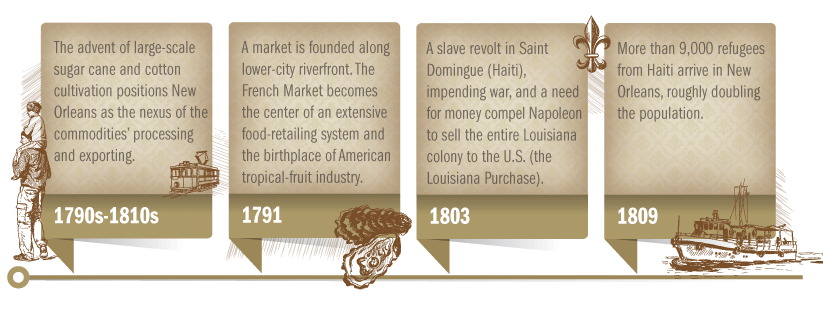
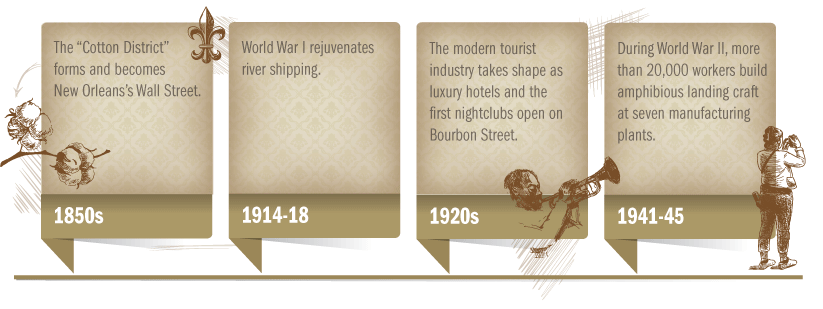
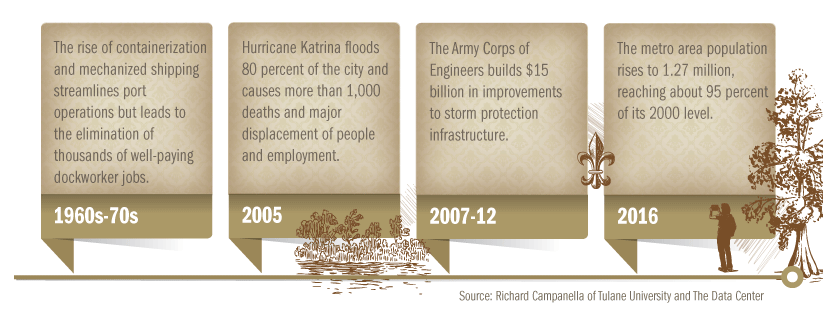
Engineering the Mighty Mississippi
In the decade after the war, a renowned feat of engineering helped revive the Crescent City economy, Campanella points out. For years, silt would clog the mouth of the Mississippi River, stranding ships trying to enter from the Gulf of Mexico. But in the late 1870s, Joseph Eads, a civil engineer who designed ironclad warships for the Union army, devised structures that narrowed the river's flow at its main outlet to the Gulf, speeding the current and allowing the river to maintain a deeper channel and permit year-round navigation.
Another economic revolution soon followed. Discoveries of oil in Beaumont, Texas, and Jennings, Louisiana, in 1901 spawned an industry that today accounts for thousands of jobs and since 1999 has reaped Louisiana an annual average of $1.2 billion in tax revenue, according to the Louisiana Department of Natural Resources. Reliable local employment data are difficult to find, but in 2016 Louisiana had nearly 75,000 jobs in the fuels sector, second only to Texas, according to the U.S. Department of Energy.
Historic preservation "best decision we've ever made"
In many ways, New Orleans is the antithesis of the typical Sunbelt boom town, where zeal for new development overwhelms preserving the past. This approach is no accident. The city's heart and soul have always been more about history, culture, and good times than commerce. Indeed, New Orleans's powerful sense of place is itself an economic asset, the main reason more than 10 million people visited the city last year and spent $7.5 billion, Romig said. He added that the upcoming tricentennial is a particular opportunity for visitors and citizens alike to renew connections between the past and present.

Mark Romig
New Orleans's personality hung in the balance in the latter 20th century. During the 1960s and '70s, New Orleans leaders and citizens made a series of decisions that would prove crucial to maintaining the city's character. To be sure, there was no all-or-nothing choice to either save the old city's charms or bulldoze indiscriminately in the name of rapid economic growth. But New Orleans did face a reckoning along those lines, recalled former Atlanta Fed New Orleans Branch director and Whitney Bank president King Milling.
In that period, the Times-Picayune newspaper notes, the "Crescent City was rapidly remaking its cityscape." The Treme neighborhood—the birthplace of jazz and an area where free people of color could buy property in the 18th and 19th centuries—was severed by an interstate overpass whose construction began in 1966. A proposal to build a raised expressway alongside the French Quarter, or Vieux Carre, was defeated in 1969 after extended debate. An exhaustive report on the quarter published just before the proposal's defeat signaled a "sea change in official thinking about the Vieux Carre," according to the Tulane School of Architecture New Orleans Preservation Timeline. "No longer considered a deteriorated slum that ought to be demolished, the historic district had become a valuable commodity worthy of extensive study," the report continues.
Meanwhile, numerous mansions more than a century old on grand St. Charles Avenue were demolished in the early 1970s and replaced by nondescript apartment buildings and commercial complexes. Discussions took place about radically altering 200-year-old cemeteries. But ultimately, after the formation of preservation groups and a city landmarks commission, the city generally began to favor saving its treasures. "In hindsight, I think it was probably the best decision we've ever made," said Milling, a New Orleans native who's been active in business and civic affairs for a half-century.
New Orleans's past represents a vast reservoir to celebrate and profit from. The city boasts major sites commemorating the struggle for civil rights; an extraordinary literary, culinary, and musical history; and of course the Vieux Carre, the nation's only intact Spanish and French colonial settlement. There are also more somber reminders of the city's history, such as its 19th-century role in the slave trade. "Our history comes in all ways," Romig said, "and to own that, to embrace that, to understand it and build on it is what we need to do from here."




